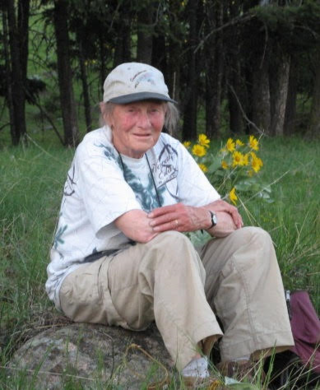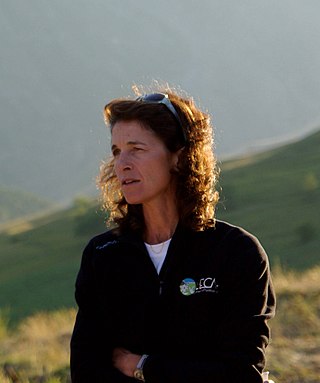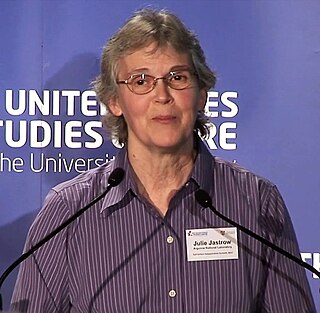Spatial ecology studies the ultimate distributional or spatial unit occupied by a species. In a particular habitat shared by several species, each of the species is usually confined to its own microhabitat or spatial niche because two species in the same general territory cannot usually occupy the same ecological niche for any significant length of time.
QDGC - Quarter Degree Grid Cells are a way of dividing the longitude latitude degree square cells into smaller squares, forming in effect a system of geocodes. Historically QDGC has been used in a lot of African atlases. Several African biodiversity projects uses QDGC, among which The atlas of Southern African Birds is the most prominent one. In 2009 a paper by Larsen et al. describes the QDGC standard in detail.

Evelyn Chrystalla "E.C." Pielou was a Canadian statistical ecologist.
A home range is the area in which an animal lives and moves on a periodic basis. It is related to the concept of an animal's territory which is the area that is actively defended. The concept of a home range was introduced by W. H. Burt in 1943. He drew maps showing where the animal had been observed at different times. An associated concept is the utilization distribution which examines where the animal is likely to be at any given time. Data for mapping a home range used to be gathered by careful observation, but nowadays, the animal is fitted with a transmission collar or similar GPS device.
Ecological forecasting uses knowledge of physics, ecology and physiology to predict how ecological populations, communities, or ecosystems will change in the future in response to environmental factors such as climate change. The goal of the approach is to provide natural resource managers with information to anticipate and respond to short and long-term climate conditions.

Species distribution modelling (SDM), also known as environmental(or ecological) niche modelling (ENM), habitat modelling, predictive habitat distribution modelling, and range mapping uses computer algorithms to predict the distribution of a species across geographic space and time using environmental data. The environmental data are most often climate data (e.g. temperature, precipitation), but can include other variables such as soil type, water depth, and land cover. SDMs are used in several research areas in conservation biology, ecology and evolution. These models can be used to understand how environmental conditions influence the occurrence or abundance of a species, and for predictive purposes (ecological forecasting). Predictions from an SDM may be of a species’ future distribution under climate change, a species’ past distribution in order to assess evolutionary relationships, or the potential future distribution of an invasive species. Predictions of current and/or future habitat suitability can be useful for management applications (e.g. reintroduction or translocation of vulnerable species, reserve placement in anticipation of climate change).
Monica G. Turner is an American ecologist known for her work at Yellowstone National Park since the large fires of 1988. She is currently the Eugene P. Odum Professor of Ecology at the University of Wisconsin–Madison.

Emma Letitia Johnston is the Dean of Science at the University of New South Wales and President of Science & Technology Australia. She is an authority in marine ecology and a former Pro Vice-Chancellor (Research) at UNSW.
Catherine H. Graham is an American team leader and senior scientist working on the Biodiversity & Conservation Biology, and the Spatial Evolutionary Ecology research units at the Swiss Federal Institute for Forest, Snow and Landscape Research WSL. From 2003 to 2017 she was an Assistant, Associate, or Full Professor of Ecology and Evolution at the Stony Brook University, and since her appointment at the WSL in 2017 she has maintained adjunct status there. She received both her M.S. degree (1995) and her Ph.D. (2000) from the University of Missouri at St. Louis, and did post-doctoral training at the Jet Propulsion Laboratory and the University of California, Berkeley. She studies biogeography, conservation biology, and ecology. Catherine H. Graham is most noted for her analysis of statistical models to describe species' distributions. This work with Jane Elith is useful in determining changes in biodiversity resulting from human activities. Her paper on niche conservatism with John J. Wiens is also highly cited. They focused on how species' retention of ancestral traits may limit geographic range expansion. In many of her papers, she has sought to unite ecology and evolutionary biology to derive a better understanding of the processes driving species diversity patterns. In particular, she and Paul Fine laid out a framework for interpreting community assembly processes from a phylogenetic approach to quantifying beta diversity.
Kerrie Ann Wilson is an Australian environmental scientist and the Pro Vice-Chancellor at Queensland University of Technology (QUT). Wilson is also an affiliated professor in conservation science at the University of Copenhagen, honorary professor at The University of Queensland, a member of the Australian Heritage Council and the Australian Natural Sciences Commissioner for UNESCO.

Gretta T. Pecl is an Australian marine ecologist, Australian Research Council Future Fellow, and the Director of the Centre for Marine Socioecology (CMS) at the University of Tasmania. Her work focuses on species and ecosystem responses to climate change, as well as using socioecological approaches to adapt natural resource management for climate change. She is on the editorial board of Springer Nature's Reviews in Fish Biology and Fisheries, and is a Subject Editor for Ecography.

Sandra Lavorel is a French ecologist specializing in functional ecology. She is a research director at the French National Centre for Scientific Research (CNRS) where she works at the Alpine Ecology Laboratory in Grenoble, France. She has been a member of the French Academy of sciences since 2013 In 2020, she was honoured to be an international member of the National Academy of Sciences.

James Benjamin Grace, aka James Grace, Jim Grace is a senior research scientist with the U.S. Geological Survey. Formerly he was a professor at Louisiana State University and associate professor at the University of Arkansas. He is an ecologist whose work has focused on science methodology, particularly the use of structural equation modeling as a means of investigating complex, system-level hypotheses.
Himabindu "Hima" Lakkaraju is an Indian-American computer scientist who works on machine learning, artificial intelligence, algorithmic bias, and AI accountability. She is currently an Assistant Professor at the Harvard Business School and is also affiliated with the Department of Computer Science at Harvard University. Lakkaraju is known for her work on explainable machine learning. More broadly, her research focuses on developing machine learning models and algorithms that are interpretable, transparent, fair, and reliable. She also investigates the practical and ethical implications of deploying machine learning models in domains involving high-stakes decisions such as healthcare, criminal justice, business, and education. Lakkaraju was named as one of the world's top Innovators Under 35 by both Vanity Fair and the MIT Technology Review.
Bette Ann Loiselle is an American neotropical ornithologist, neotropical ecologist, and conservation biologist.

Catherine Ellen Lovelock is an Australian marine ecologist, whose research focuses on coastal ecosystems. She is a professor in the School of Biological Science at the University of Queensland and 2020 Georgina Sweet Australian Laureate Fellow.
Liza Sheera Comita is an American ecologist and Professor of Tropical Forest Ecology in the School of the Environment at Yale University. Her research considers the plant community.

Halotydeus destructor is a species of earth mites in the family of Penthaleidae, first described by Tucker in 1925 as Penthaleus destructor.

Julie Dierstein Jastrow is an American terrestrial ecologist who works at the Argonne National Laboratory. Her research considers soil and ecosystems ecology. She was elected Fellow of the American Association for the Advancement of Science in 2021.

Lauren B. Buckley is an evolutionary ecologist and professor of biology at the University of Washington. She researches the relationship between organismal physiological and life history features and response to global climate change.









